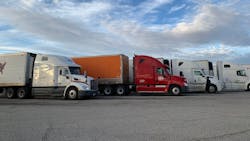In a Fleet Owner article looking towards the next decade, it was said that “numerous freight transportation experts suggested there is likely to be more advancements during the next 10 year than in the past five decades combined.”
In that article, Daimler Trucks North America’s Roger Nielsen said, “you can’t bring fuel efficiency changes every day.”
I am sure Nielsen was talking from a manufacturing point of view. But the same can be said from a technology adoption point of view. In our Annual Fleet Fuel Study we look at fleet adoption of 85 different technologies and practices. Sometimes you do see huge increases in the adoption rate of a specific technology from one year to the next.
For example, in the 2019 study we saw a 1,389% increase in the adoption rate of tractor gap reducers and a 126% increase in the use of solar panels from 2017 to 2018. And after years of slow growth in automated technologies, they moved from 25 to 70% in just three years! But what is more normal is a slower adoption over a period of years.
This is due in part because the vast diversity of needs in the industry can make the adoption of a specific fuel-saving technology slow, as it might not be suited for all applications. Also, fleets have multiple demands and challenges including access to capital, levels of risk tolerance, whether they buy or lease their vehicles, whether they have company drivers or use independent contractors, whether they do their own maintenance or outsource it. The list goes on and on. And, of course, there is the fact that trucks have different duty cycles and operate in different geographic locations. Wow, the many challenges when deciding what and when to buy.
What we’ve learned from years of conducting the Fleet Fuel Study is that technologies take a long time to scale from small deployment projects to use by innovative fleets and early adopters to late adopters and laggards. At that point the new product has reached a saturation point and most fleets are receiving value from it. Think trailer skirts and down sped powertrains.
One other thing we learned from the Fleet Fuel Studies is that current diesel fuel prices are not the only motivating factor in a fleet’s decision to invest in fuel-saving technology. They also look at things like regulations and sustainability. More on that in a future blog.
I suspect that no matter what the technology, we will continue to see adoption rates follow the normal pattern we’ve seen for a variety of other technologies over the years.
About the Author

Michael Roeth
Executive Director
Michael Roeth is the executive director of the North American Council for Freight Efficiency. He serves on the second National Academy of Sciences Committee on Technologies and Approaches for Reducing the Fuel Consumption of Medium and Heavy-Duty Vehicles and has held various positions with Navistar and Behr/Cummins.
